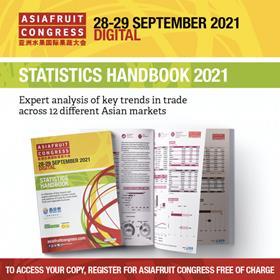
The impact of the Covid-19 pandemic on Asia’s fresh produce trade is revealed in the 2021 edition of the Asiafruit Congress Statistics Handbook.
The annual statistical guide to Asia’s fresh fruit and vegetable trade is launched by Asiafruit Magazine and Asia Fruit Logistica at Asiafruit Congress on 28-29 September 2021.
The Statistics Handbook underlines the effects of Covid-19-driven supply chain disruption – from labour to logistics – which hit the global fresh produce trade in 2020. Supply of global fresh produce into most Asian markets decreased as a result.
However, intra-Asia fresh produce trade, which accounts for the majority of fresh fruit and vegetable trade in the region, grew by almost 5 per cent year-on-year in 2020, offsetting declines in imports from global suppliers.
The Statistics Handbook presents not just numbers, but also informed analysis, helping the industry to make sense of production, supply, and patterns of trade across 12 different Asian markets.
“Never has data been more critical to shaping our daily business decisions,” said Wayne Prowse of Fresh Intelligence Consulting, who produces the market analysis for Asiafruit Congress Statistics Handbook. “The Asiafruit Congress Statistics Handbook continues to generate a wealth of statistical information to support the dynamic fresh produce business throughout Asia as it deals with the disruptions of the Covid-19 era.”
“This year’s handbook reveals that fresh fruit imports declined across a number of key Asian markets in 2020, including China, Indonesia and India,” said John Hey, editor of Asiafruit Magazine. “However, several markets recorded growth in fruit imports, most notably Thailand, but also Vietnam, which has become Asia’s largest apple importer.
“There were also strong gains for key products across various markets, such as avocado imports to South Korea, Vietnamese dragon fruit exports and New Zealand kiwifruit exports to Japan.”
Comparative analysis
Analysis of each of the 12 markets covered in the Statistics Handbook includes fresh fruit and vegetable import and export volumes for 2020. These are broken down by product for a year-on-year comparison together with charts revealing the five-year trend for total fruit and vegetable import/export volumes.
The market share of suppliers for key import products are displayed in pie-charts. Plus, there are charts and tables to show fresh fruit and vegetable production by product; trade balance; the relative share of tropical and temperate fruit imports; and consumption volumes for fruit and vegetables.
In addition, the Statistics Handbook features a Fresh Fruit Trade Lanes Map. The map details the volume of fresh fruit imports to Asia in 2020 from major supplying regions across the world compared with the previous year, and it records their relative market share.
The Asiafruit Congress Statistics Handbook is produced by Fruitnet Media International and launched by Asiafruit Magazine and Asia Fruit Logistica at Asiafruit Congress.
To access your copy, register for Asiafruit Congress on 28-29 September 2021. You can register for Asiafruit Congress free of charge here.
The next edition of Asia Fruit Logistica returns to Hong Kong’s AsiaWorld-Expo on 7-9 September 2022, and Asiafruit Congress takes place on 6 September 2022.



